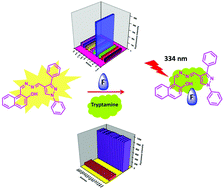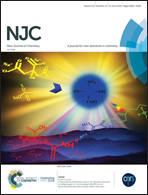Dual-mode recognition of biogenic amine tryptamine and fluoride ions by a naphthyl hydrazone platform: application in fluorescence imaging of HeLa cells and zebrafish embryos†
Abstract
A novel, selective and sensitive naphthyl hydrazone anchored Schiff base derivative 1-((E)-((E)-((1,3-diphenyl-1H-pyrazol-4-yl)methylene)hydrazono)methyl)naphthalen-2-ol (PYNA) has been fabricated, synthesized and efficiently applied to the fluorogenic and chromogenic recognition of both tryptamine (TryptA) and F− ions. The probe PYNA disclosed strong ratiometric absorbance to TryptA amidst the other tested amines and anions. Moreover, the fluorescence data suggest that inhibition of excited state intramolecular proton transfer (ESIPT) takes place through fluorescence enhancement in the presence of TryptA and F− ions for the probe PYNA. The 1 : 1 binding stoichiometry of PYNA with TryptA/F− ions has been determined from the Job plot based on UV-visible and fluorescence methods. In addition, the binding sites of PYNA–TryptA/F− have been established from ESI-MS (Electrospray Ionization Mass Spectrometry), 1H NMR titration, 19F NMR and DFT calculations. In vivo analysis of both TryptA/F− in zebrafish embryos and intracellular detection of F− in HeLa cells indicates that PYNA has good cell permeability and biocompatibility and could act as an excellent biologically potent chemical device.



 Please wait while we load your content...
Please wait while we load your content...